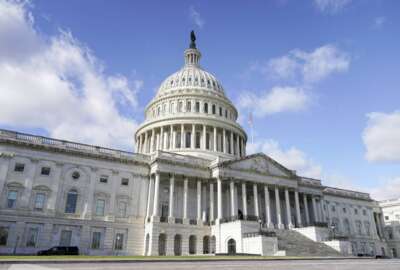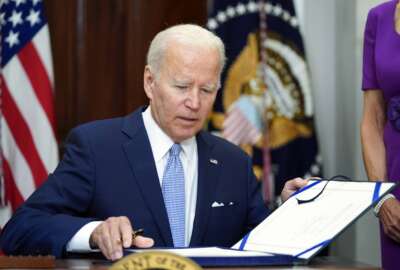Biden proposes 2% federal pay raise in 2025 budget request
Along with a proposed 2% federal pay raise for 2025, the Biden administration is looking at reforms for federal firefighters, as well as FAA and TSA employees.
Although fiscal 2024 government spending is still largely uncertain in Congress, the White House is already turning its attention to next year’s budget — and the federal pay raise for 2025.
The Biden administration is asking Congress for $1.63 trillion for defense and non-defense discretionary accounts in 2025, which is $11 million, or 0.7%, over the enacted levels for 2023. The new spending proposal breaks down to $895 billion for defense spending and $734 billion for non-defense spending, 4.3% above and 3.4% below the enacted 2023 spending levels, respectively.
Given the current climate on Capitol Hill, the 2025 budget request is unlikely to find its way through Congress unscathed. But the White House’s proposal, released Monday, is considered the opening bid for government spending next fiscal year. It’s also a major indicator of what the administration will focus on over the next year.
For federal employees, what may be one of most impactful parts of the President’s budget request is next year’s federal pay raise.
For 2025, the White House is pushing for a more modest 2% federal pay raise for the roughly 1.5 million federal employees on the General Schedule.
If enacted, most civilian federal employees would see the boost to their paychecks starting in the first full pay period of January 2025. Military members would receive a 4.5% raise next year, according to the budget request.
The percentage adjustment would be the smallest pay raise since President Joe Biden took office. Federal employees received raises of 5.2%, 4.6% and 2.7%, in 2024, 2023 and 2022, respectively. In all three years, Biden’s federal pay raise proposals were finalized without intervention from Congress.
The Biden administration said it opted for the smaller raise proposal for 2025 due to financial constraints agencies are expected to face over the next fiscal year.
At the same time, more long-term fixes to the federal pay system remain a priority for the administration, the Office of Management and Budget said. Now a year after Biden hinted at plans to fix the pay compression Senior Executive Service members, higher-level General Schedule employees, and blue-collar workers on the Federal Wage System experience, the White House pointed to a couple possible options to pursue. Those include increasing Executive Schedule rates, removing pay caps in the Federal Wage System and modifying how pay rates are adjusted each year.
“The administration continues to prioritize federal compensation and also looks forward to working with Congress to address long-standing issues of pay compression, which impact employees at various levels throughout the government,” OMB said in the budget documents. “By continuing to pursue structural improvements and use of flexibilities, we will enhance the competitiveness of the federal pay system.”
The budget request does not detail how the raise would break down between the across-the-board percentage and locality pay adjustments. If tradition stands, the federal pay raise would likely comprise a 1.5% base raise for feds, plus an average of a 0.5% locality pay boost. But the administration will not finalize that breakdown at least until Biden releases an alternative pay plan in August.
The federal pay raise proposal in the budget request is only the first step of the process for finalizing the amount federal employees will see added to their paychecks next year.
Each year, a president will typically submit an alternative pay plan to Congress in August, which incorporates the initial proposal from the budget request. The President will then sign an executive order by the end of the calendar year to make the pay raise official for the following January.
A 2% federal pay raise is also well below what some House and Senate Democrats are calling for next year. The Federal Adjustment of Income Rates (FAIR) Act is proposing a 7.4% raise for civilian federal employees in 2025.
“While every pay raise is a step in the right direction after decades of disinvestment in the federal workforce, our legislation remains the best option for ensuring federal employees are fairly and properly compensated for their service,” Rep. Gerry Connolly (D-Va.), who introduced the FAIR Act, said in a statement to Federal News Network.
Other workforce priorities in 2025 budget request
Of course, the federal pay raise proposal is far from the only priority for the federal workforce contained in the 2025 budget request. In the proposal, the Biden administration pointed to new goals for improving the federal workforce, as well as its plans to strengthen existing goals.
For one, the budget request calls on agencies to improve the federal hiring process, in part through scaling up the use of shared certificates and pooled hiring. Shared certificates let federal job applicants submit one application, which multiple agencies can then consider for common positions that aren’t specific to one agency. The budget request touted success of the recruitment strategy for hiring 6,100 feds through the Infrastructure Investment and Jobs Act.
Additionally, the budget request maintains a focus on early-career federal hiring, which has been a priority at agencies for several years. Currently, less than 7% of the federal workforce is under age 30.
The new proposal particularly emphasized the importance of expanding access to paid federal internships and promoting early-career job opportunities in government.
Just last week, Biden signed an executive order telling agencies to also make better use of registered apprenticeships as another pathway into federal service. Now the administration is asking Congress for $335 million — an increase of $50 million over the enacted 2023 level — to invest in the Labor Department’s registered apprenticeship program.
“This investment would also be used to increase the number of workers from historically underrepresented groups, including people of color, women and people with disabilities, who participate in registered apprenticeships,” the budget request said.
The administration also emphasized investments in more general recruitment and retention goals, for example, through the Office of Personnel Management’s Hiring Experience Office.
“As the government faces increasingly complex challenges, the need for federal leaders, managers and frontline staff with the right skills in the right jobs has never been greater,” the budget request said.
The White House is also proposing further investments in the “Trusted Workforce 2.0” strategy, which aims to bolster cybersecurity and personnel vetting procedures governmentwide.
Some agencies would also see specific investments for frontline employees working in government. Notably, the budget request pushes for a permanent pay raise for federal wildland firefighters, as well as other workforce reforms for the frontline employees, including more staffing, better health services and improved housing for federal firefighters — totaling $135 million above the 2023 enacted level for the Interior Department, and $387 million over the 2023 enacted level for Department of Agriculture’s Forest Service.
The investments “would help address long-standing recruitment and retention challenges, increase … capacity to complete critical risk mitigation work, and further the administration’s commitment to build a more robust and resilient wildland firefighting workforce as the frequency and intensity of catastrophic wildfires continue to increase due to climate change,” the budget request said.
The Transportation Security Administration would receive an additional $1.5 billion to continue funding the TSA pay equity initiative. The initiative gave TSA employees a pay raise beginning in July 2023.
“The TSA workforce deserves to be fairly compensated at rates comparable with their peers in the federal workforce,” the budget request said. “TSA has already seen an 11% reduction in attrition, and is making gains in retaining what has historically been a workforce with high turnover.”
The Federal Aviation Administration would get $17.5 billion in its discretionary budget authority, according to the budget request. It’s an increase of $2.1 billion above the 2023 enacted level. The funding would go toward more hiring and training of air traffic controllers, modernization investments and increased safety capabilities, the budget request said.
The budget request is also targeting recruitment for AI jobs in government. The Biden administration is proposing an investment of $32 million for the U.S. Digital Service, General Services Administration and OPM to continue working toward a governmentwide AI talent surge, first launched in October 2023.
Since this year is a presidential election year, the 2025 budget request is the last proposal for the first term of the Biden administration. But with only half of congressional appropriations bills so far determined for 2024, the path to reaching a spending agreement for agencies in 2025 may remain uncertain for months to come.
On March 9, Biden signed a $460 billion package of spending bills just in time to avoid a partial government shutdown. The House and Senate now have a deadline of March 22 to reach a spending agreement for many other agencies — before getting around to considering agency funding and priorities for fiscal 2025.
Copyright © 2025 Federal News Network. All rights reserved. This website is not intended for users located within the European Economic Area.
Drew Friedman is a workforce, pay and benefits reporter for Federal News Network.
Follow @dfriedmanWFED






